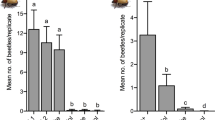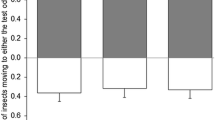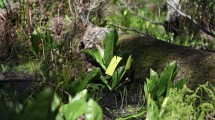Abstract
The attractiveness of volatile compounds from the floral scent of Rosa, one of the most preferred plants for adult Hoplia communis, was evaluated under field conditions. The beetles were attracted to most compounds tested, but 2-phenylethanol exhibited the highest capture rate. Catches increased with increasing emissions of between 9.1 and 287.2 mg/day. Catches in white traps were significantly larger (17.4-fold) than those in green traps when both were baited with anethole, an already known attractant; however, the trap color was not significant when a more attractive lure, 2-phenylethanol, was used. The use of a single funnel trap baited with 2 g of 2-phenylethanol at a heavily infested nursery exhibited promising results for mass trapping. Approximately 90,000 beetles of both sexes, which nearly corresponds to the estimated maximum population per 1000 m2, were captured within six days.
Similar content being viewed by others
REFERENCES
Dobson, H. E. M., BergstrÖm, G., and Groth, I. 1990 Differences in fragrance chemistry between flower parts of Rosa rugosa Thumb. (Rosaceae). Isr. J. Bot. 39:143–156.
Hatsukade, M. 1995. Color Atlas: Major Insects of Turfgrasses and Trees on Golf Courses—Life Cycle, Damage and Control. Soft Science Publications, Tokyo. 121 pp. (in Japanese).
Hairai, J. 1993. Chafers, pp. 56–59, in S. Kamano, K. Shimizu, H. Sugie, S. Tatsuki, S. Wakamura, and K. Morita (eds.). Sei pheromone zai to shiyo no tebiki (A guide for application of semiochemicals). Nihon Shokubutu Boeki Kyokai, Tokyo (in Japanese).
Ikka, T. 1996. The state of prevalence of long–legged chafter in turf cultivation. Ibaraki–ken Byougaichuu Kenkyuukaihou 35:29–31 (in Japanese).
Ishikawa, Y., Ikeshoji, T., and Matsumoto, Y. 1983. 2–Phenylethanol: An attractant for the onion and seed–com flies, Hylemye antique and H. platura (Diptera: Anthomyiidae). Appl. Entomol. Zool. 18:270–277.
Knudsen, J. T., Tollsten, L., and BergstrÖm, L. G. 1993 Floral scents—A checklist of volatile compounds isolated by head space techniques. Phytochemistry 33:253–280.
Kobayashi, J. 1985. Tribe Hoplini, pp. 386–387, in S. Ueno, Y. Kurosawa, and M. Sato (eds.). The Coleoptera of Japan in Color, Vol. II. Hoikusha, Osaka (in Japanese).
Lanier, G. N. 1990. Principles of Attraction—Annihilation: Mass: Trapping and Other Means, pp. 25–45, in R. L. Ridgway, R. M. Silverstein, and M. N. Inscoe (eds.). Behavior–Modifying Chemicals for Insect Management. Marcel Dekker, New York.
Leal, W. S., Oono, M. Hasegawa, M., and Sawada, M. 1994. Kairomone from dandelion, Taraxacum officinale, attractant for scarab beetle Anomala octiescostata. J. Chem. Ecol. 20:1697–1704.
Metcalf, R. L. and Metcalf, E. R. 1992. Plant Kairomones in Insect Ecology and Control. Chapman and Hall, New York, 168 pp.
Mookherjee, B. D., Trenkle, R. W., and Wilson, R. A. 1990. The chemistry of flowers, fruits, and spices: Live vs. dead a new dimension in fragrance research. Pure Appl. Chem. 62:1357–1364.
Yokomizo, K. and Nagata, K. 1984. Attractants for scarabaeid beetles. Shokubutu–Boeki 38:403–406 (in Japanese).
Author information
Authors and Affiliations
Rights and permissions
About this article
Cite this article
Imai, T., Maekawa, M., Tsuchiya, S. et al. Field Attraction of Hoplia communis to 2-Phenylethanol, A Major Volatile Component from Host Flowers, Rosa spp.. J Chem Ecol 24, 1491–1497 (1998). https://doi.org/10.1023/A:1020907732706
Issue Date:
DOI: https://doi.org/10.1023/A:1020907732706




